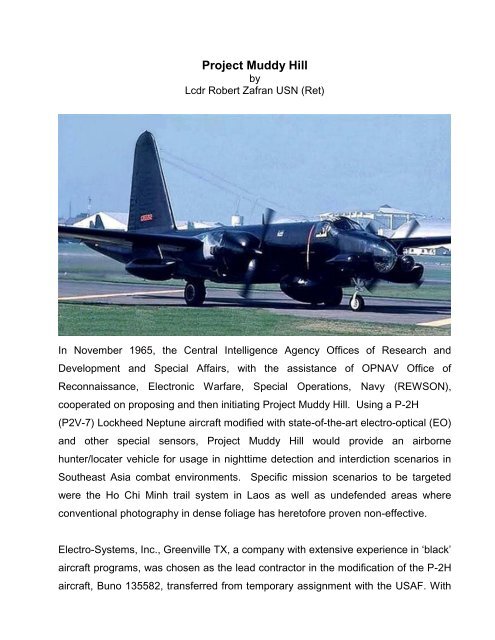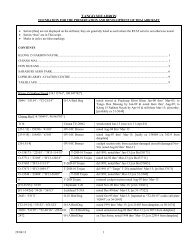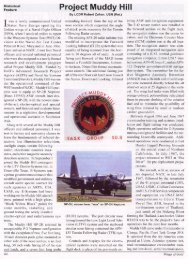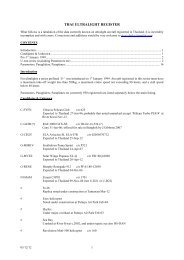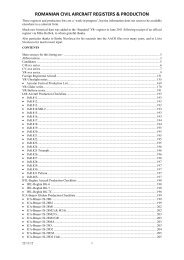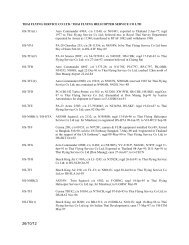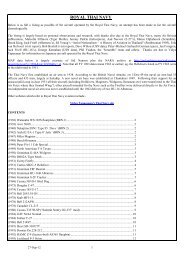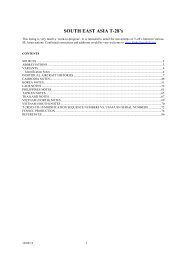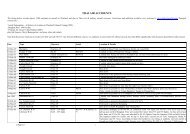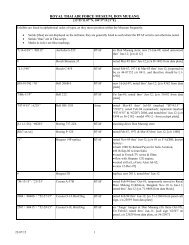Project Muddy Hill - Thai Aviation History
Project Muddy Hill - Thai Aviation History
Project Muddy Hill - Thai Aviation History
You also want an ePaper? Increase the reach of your titles
YUMPU automatically turns print PDFs into web optimized ePapers that Google loves.
<strong>Project</strong> <strong>Muddy</strong> <strong>Hill</strong><br />
by<br />
Lcdr Robert Zafran USN (Ret)<br />
In November 1965, the Central Intelligence Agency Offices of Research and<br />
Development and Special Affairs, with the assistance of OPNAV Office of<br />
Reconnaissance, Electronic Warfare, Special Operations, Navy (REWSON),<br />
cooperated on proposing and then initiating <strong>Project</strong> <strong>Muddy</strong> <strong>Hill</strong>. Using a P-2H<br />
(P2V-7) Lockheed Neptune aircraft modified with state-of-the-art electro-optical (EO)<br />
and other special sensors, <strong>Project</strong> <strong>Muddy</strong> <strong>Hill</strong> would provide an airborne<br />
hunter/locater vehicle for usage in nighttime detection and interdiction scenarios in<br />
Southeast Asia combat environments. Specific mission scenarios to be targeted<br />
were the Ho Chi Minh trail system in Laos as well as undefended areas where<br />
conventional photography in dense foliage has heretofore proven non-effective.<br />
Electro-Systems, Inc., Greenville TX, a company with extensive experience in ‘black’<br />
aircraft programs, was chosen as the lead contractor in the modification of the P-2H<br />
aircraft, Buno 135582, transferred from temporary assignment with the USAF. With
Lcdr Bob Porter as Officer-in-Charge and Lcdr Dale Hagen as Assistant Officer-in-<br />
Charge, Navy, Marine, and Air Force officer and enlisted personnel as well as civil<br />
service and EO systems contractor personnel were assigned to <strong>Muddy</strong> <strong>Hill</strong> to fulfill<br />
the function of flight crew and maintenance support during the aircraft and systems<br />
test phase at Greenville and while the <strong>Project</strong> was deployed to Southeast Asia. The<br />
Weapons Systems Test Division, Naval Air Test Center (NATC), maintained<br />
administrative control of assigned personnel while operational control {when<br />
deployed to Southeast Asia) was maintained by Commander in Charge, Pacific<br />
Fleet. When deployed, <strong>Muddy</strong> <strong>Hill</strong> operated as Pacific Fleet Task Group 50.8.<br />
During June to August 1966, several <strong>Muddy</strong> <strong>Hill</strong> Navy officers and enlisted<br />
personnel were sent to factory and university classes to study the fundamentals of<br />
infrared detection, low light illumination television, starlight scope, terrain following<br />
radar, electronic counter measures, and active magnetic anomaly detection<br />
systems. In September 1966, <strong>Muddy</strong> <strong>Hill</strong> personnel reported to E-Systems to<br />
assume an active roll in the ongoing modification and testing of the Neptune aircraft,<br />
now re-designated a NP-2H (permanent test-bed aircraft). The aircraft was<br />
repainted with a high-gloss, ‘Black Widow Black’ paint (used on several WWII fighter<br />
aircraft) that transformed the surface area into an optical virtual image, obliquely<br />
scattering nighttime illumination sources impinging on the aircraft so that it was<br />
essentially invisible!<br />
The <strong>Muddy</strong> <strong>Hill</strong> NP-2H retained its recognizable P2 Neptune external configuration<br />
with the exception of two, five-foot long, 2 1/2 foot diameter circular fairings (pods)<br />
mounted on either side of the nose section. The port pod housed the Low-Light-<br />
Level Television (L 3 TV) system and the starboard pod the APQ-115 Terrain<br />
Following Radar (TFR) system. A six-foot long, 2 1/2 foot wide fairing aft of the rear<br />
exit hatch housed the two Stereo, Downward Looking Infrared (DLIR) systems. A
seven-foot long outside air intake probe extending forward from the top of the nose<br />
section supported the TFR system angle of attack flying-wing device. The forward<br />
section of the existing APS-20 radar radome incorporated the Forward Looking<br />
Infrared (FLIR) system that was capable of being scanned from the horizon to 20 0<br />
aft of nadir. A small faring just forward of the MAD boom housed a Fairchild<br />
Instruments, horizon-to-horizon, 70mm format reconnaissance camera.<br />
The Active Magnetic Anomaly Detection transmitter was a 36-inch diameter coil of<br />
#8 solid copper wire tilted 25 0 to the vertical mounted directly behind the aft observer<br />
seats with controls located at the flight deck sensor station. The Neptune’s wing fuel<br />
tanks were filled with orange-colored, polyurethane reticulated foam to minimize fuel<br />
sloshing and the possibility of wing fires initiated by small to medium caliber ground-<br />
fire.<br />
Controls and displays for the FLIR, L 3 TV, TFR and Active Magnetic Anomaly<br />
Detection sensors were installed at the flight deck sensor station, forward on the<br />
flight deck. The navigation station was centrally located on the flight deck with a<br />
B-52 bomb guidance/navigation computer, Litton LN15 inertial system, APN-92<br />
Loran C and APN-122 Doppler groundspeed/drift navigation system comprising the<br />
integrated navigation suite. The active and passive electronic countermeasures<br />
(ECM/ESM) equipment was located on the flight station, just forward of the wing<br />
beam.<br />
Between August 1966 and June 1967, crewmember training and EO systems flight<br />
tests were conducted utilizing Electro-Systems runways and ground facilities and<br />
the surrounding Greenville countryside. Additional systems test operations in<br />
simulated Southeast Asia environments were conducted at the Fort Hunter Liggett<br />
Proving Grounds on the central coast of Northern California. In July 1967, the<br />
project relocated to NATC Patuxent Rived MD, for pre-deployment preparations.
The <strong>Muddy</strong> <strong>Hill</strong> aircraft, with an aircrew of six, departed NATC in late July 1967,<br />
followed by twenty seven military, civilian contractor and civil service project<br />
personnel and support equipment via an USAF MAC C-141 aircraft for Udorn Thani,<br />
Royal <strong>Thai</strong> Air Force Base (Udorn RTAFB). Udorn RTAFB was located in the<br />
northeastern sector of <strong>Thai</strong>land, just south of the Mekong River forming the<br />
<strong>Thai</strong>land-Laos border. The Air America compound at Udorn RTAFB was the<br />
project’s staging area for the next four months.<br />
Aircraft avionics systems test and road reconnaissance crewmember training flights<br />
were conducted around the Udorn area. Combat environment, aerial<br />
reconnaissance missions were conducted during both daytime and nighttime hours<br />
in the ‘Barrel Roll’ and ‘Tiger Hound’ areas of Laos. Military operational missions<br />
were fully briefed with intelligence, defensive threat scenarios, and conjunctive<br />
military flight operations in the mission areas. Target areas consisted of the Ho Chi<br />
Minh Trail and its road segments as well as other locations in the Plaine des Jarres<br />
in central Laos. Flight durations averaged 4-5 hours with takeoffs around 0500 and<br />
1900 hours. While at Udorn RTAFB, the pilot and co-pilot’s seats were reinforced<br />
with seat armor salvaged from crashed Army helicopters.<br />
Mission flight parameters varied between 200 and 1500 feet absolute altitude on<br />
terrain following radar in the rugged, mountainous terrain of Laos. Primary target<br />
area guidance was accomplished by the author’s usage of a hand-held starlight<br />
(night vision) scope in the aircraft’s Plexiglas bow observer station. The author used<br />
the night vision scope imagery to locate road segments, navigation waypoints and<br />
individual targets. Voice commands via the aircraft’s inter-communication system<br />
were used to direct the plane commander to target locations. Usage of the night<br />
vision scope by the author also provided terrain avoidance to complement terrain<br />
following radar electronic commands. Suspected targets of interest were marked<br />
airborne flare parachutes that had been impregnated with green, chemiluminescent
dye. These flare parachutes were dropped from the sonobuoy dispensing chutes<br />
located in the aft portion of the aircraft. Several tactical missions experienced light,<br />
small arms ground fire with two missions encountering automatic anti-aircraft<br />
opposition.<br />
The Stereo DLIR system imprinted IR images directly on two rolls of 70mm format<br />
film. After processing at the USAF photo laboratory, this film was analyzed by<br />
photographic intelligence trained <strong>Muddy</strong> <strong>Hill</strong> personnel using a specially designed<br />
stereoscopic viewer. Tactically significant target information was reported to the<br />
USAF intelligence center at Udorn RTAFB.<br />
From August to December 1967, <strong>Project</strong> <strong>Muddy</strong> <strong>Hill</strong> (TG 50.8) completed a total of<br />
60 avionics systems test/road reconnaissance-training flights. 14 flights (62 flight<br />
hours) consisting of low-level, active combat environment reconnaissance missions<br />
were also successfully completed. The <strong>Muddy</strong> <strong>Hill</strong> overseas deployment was<br />
terminated when the aircraft and project personnel returned to NATC in December<br />
1967. <strong>Project</strong> <strong>Muddy</strong> <strong>Hill</strong> continued at NATC with several Navy officers becoming<br />
part of the Electronic Warfare Section, Weapons Systems Test Division, writing the<br />
necessary formal <strong>Muddy</strong> <strong>Hill</strong> Test Reports. Throughout 1968, the author crewed the<br />
<strong>Muddy</strong> <strong>Hill</strong> aircraft, Buno 135582, with additionally installed EO/other sensors,<br />
during surface ship reconnaissance and ASW scenario evaluation flights. NP-2H<br />
Buno 135582 remained at NATC as a permanent test bed aircraft, being assigned to<br />
MASDC, Davis Monthan AFB AZ in December 1970 and removed from U.S. Navy<br />
Inventory May 1971.<br />
The first NATC test and evaluation project to operate in Southeast Asia, <strong>Project</strong><br />
<strong>Muddy</strong> <strong>Hill</strong>, successfully utilized the first airborne EO systems to be operationally<br />
evaluated in a combat environment. These systems served as the predecessor of<br />
more modern EO systems also successfully used in Vietnam combat in 1968-1969
on AP-2H aircraft of Heavy Attack Squadron 21 and later on carrier-based A-6C<br />
Intruder aircraft. Additionally, <strong>Muddy</strong> <strong>Hill</strong>’s unique avionics systems became the first<br />
EO sensors successfully deployed against submarine and small surface targets in<br />
nighttime environments.<br />
<strong>Project</strong> <strong>Muddy</strong> <strong>Hill</strong><br />
Barrel Roll Tactical Mission Crew<br />
12 Oct 1967 Udorn RTAFB <strong>Thai</strong>land<br />
Left to Right..<br />
AO2 W. Seal..<br />
ATN2 B. Burner..<br />
Lt Lon Brugh..<br />
Ltjg Bob Zafran..<br />
Lcdr Bob Porter {OinC}..<br />
Lcdr Dale Hagen {Asst OinC}..<br />
Lt Col Bill Kovalick..<br />
ADR1 Bob Tappan


